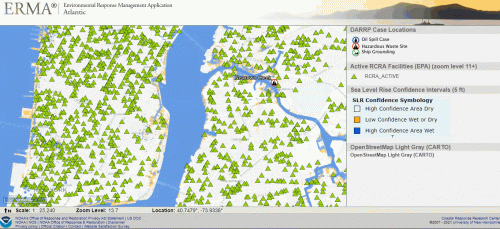Map of the Month: Sea Level Rise
Damage assessments and restoration, today’s land—tomorrow’s ocean.
The Environmental Response Management Application (ERMA®) is NOAA’s online mapping tool that integrates both static and real-time data, enabling users to quickly and securely access, analyze, and display spatial data. The "Map of the Month" series highlights unique maps from throughout ERMA's use and history.
This animated map of Fulton Street in New York City shows several things: 1. Projected sea level rise of six feet, 2. Potential toxic hazards, like generators, that could pose problems during flood events, and 3. Where projected sea level rise and these hazards overlap.
Sea level rise is one of the biggest risks for coastal communities today and far into the future. Flooding is occurring more frequently as has the severity of the floods. Sea level rise not only causes more flooding but it also impacts the habitat of coastal communities. The Office for Coastal Management maintains a Sea Level Rise Viewer, that illustrates potential flooding from future sea level rise—from current mean and higher high water to a six-foot rise.
The Office of Response and Restoration has integrated this data into its common operational viewer, ERMA. Resource managers can use the sea level rise information to aid in the viability of any long term restoration projects or damage assessments. In the map pictured, Environmental Protection Agency Resource Conservation and Recovery Act (RCRA) data are paired with a six-foot sea level rise scenario in New York City. The RCRA data track generators, transporters, treaters, storers, and disposers of hazardous waste and when paired with the sea level rise, managers can identify sites that are at a greater flood risk. Visualization of sea level rise data, along with data from hazardous waste sites or spills, enables resource managers to make informed decisions for remediation and restoration projects.
This Map of the Month is brought to you by the Office of Response and Restoration’s Assessment Restoration Division’s Jay Coady. Special thanks to the NOAA Office for Coastal Management. Their mapping data for sea level rise was used in this Map of the Month.
 An official website of the United States government.
An official website of the United States government. 
